Strategic Finance: CAPM and APT Conceptual Issues Analysis Report
VerifiedAdded on 2023/01/10
|10
|2682
|50
Essay
AI Summary
This essay delves into the Capital Asset Pricing Model (CAPM) and Arbitrage Pricing Theory (APT) within the context of strategic finance. It begins by highlighting the importance of CAPM in determining the cost of capital and its role in investment decision-making, emphasizing the relationship between risk and expected return. The essay explores the assumptions underlying CAPM, including diversification and true portfolio assumptions, while also addressing criticisms related to their realism. It then examines alternative models, such as arbitrage pricing models and three-factor models, and discusses the benefits of CAPM, such as its ease of calculation and its ability to consider risk. The essay provides an evaluation of CAPM, acknowledging its widespread use while also considering its limitations. It also discusses the importance of beta and risk-free rate in the calculation of the cost of equity capital. The content also includes an overview of the alternative models, the benefits of CAPM, and the criticisms surrounding the model. The essay concludes that despite criticisms, CAPM remains a relevant tool for financial analysis and decision-making. The provided material includes an assessment rubric, and references to academic literature which helps in the understanding of the topic.

1
Strategic Finance
Strategic Finance
Paraphrase This Document
Need a fresh take? Get an instant paraphrase of this document with our AI Paraphraser
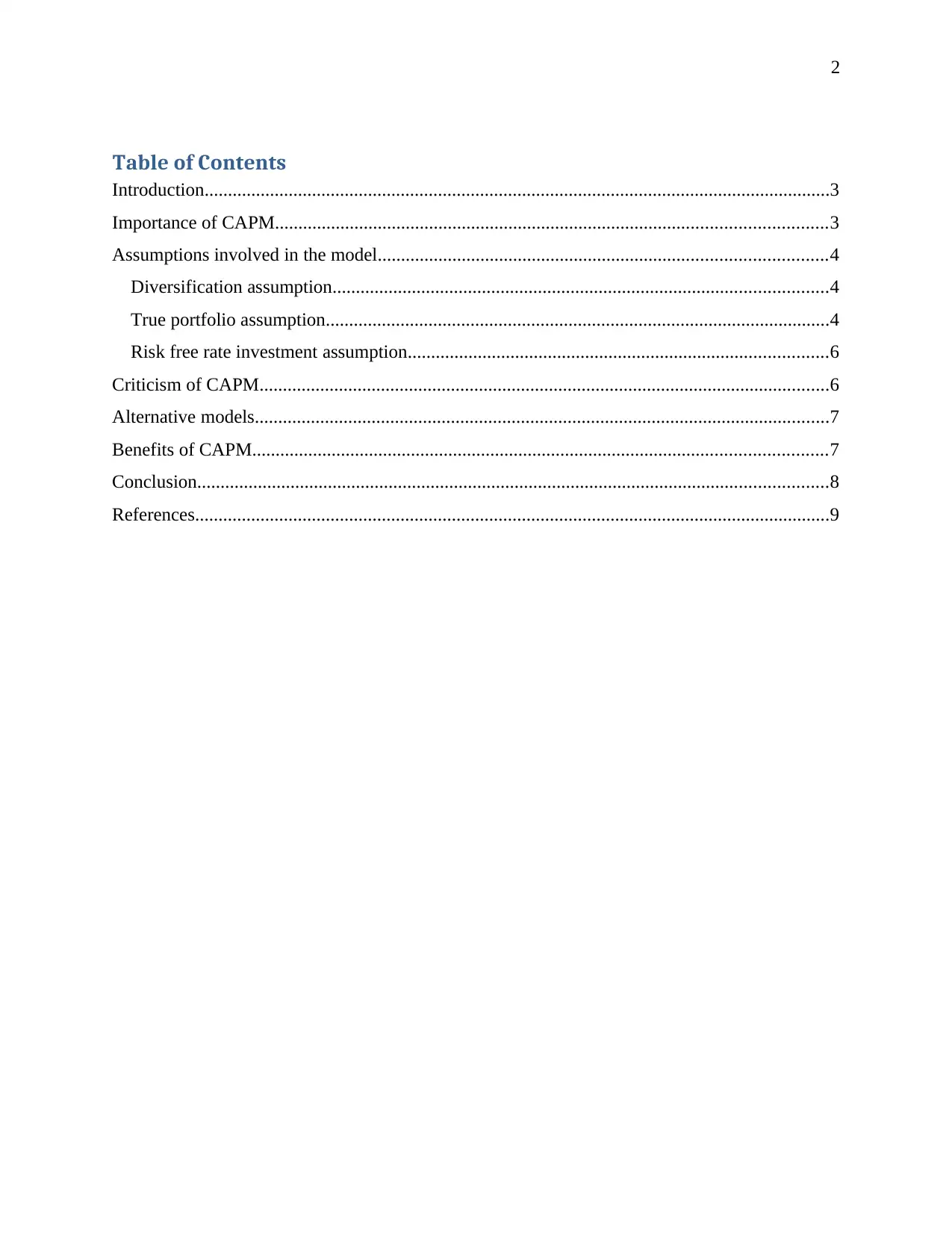
2
Table of Contents
Introduction......................................................................................................................................3
Importance of CAPM......................................................................................................................3
Assumptions involved in the model................................................................................................4
Diversification assumption..........................................................................................................4
True portfolio assumption............................................................................................................4
Risk free rate investment assumption..........................................................................................6
Criticism of CAPM..........................................................................................................................6
Alternative models...........................................................................................................................7
Benefits of CAPM...........................................................................................................................7
Conclusion.......................................................................................................................................8
References........................................................................................................................................9
Table of Contents
Introduction......................................................................................................................................3
Importance of CAPM......................................................................................................................3
Assumptions involved in the model................................................................................................4
Diversification assumption..........................................................................................................4
True portfolio assumption............................................................................................................4
Risk free rate investment assumption..........................................................................................6
Criticism of CAPM..........................................................................................................................6
Alternative models...........................................................................................................................7
Benefits of CAPM...........................................................................................................................7
Conclusion.......................................................................................................................................8
References........................................................................................................................................9
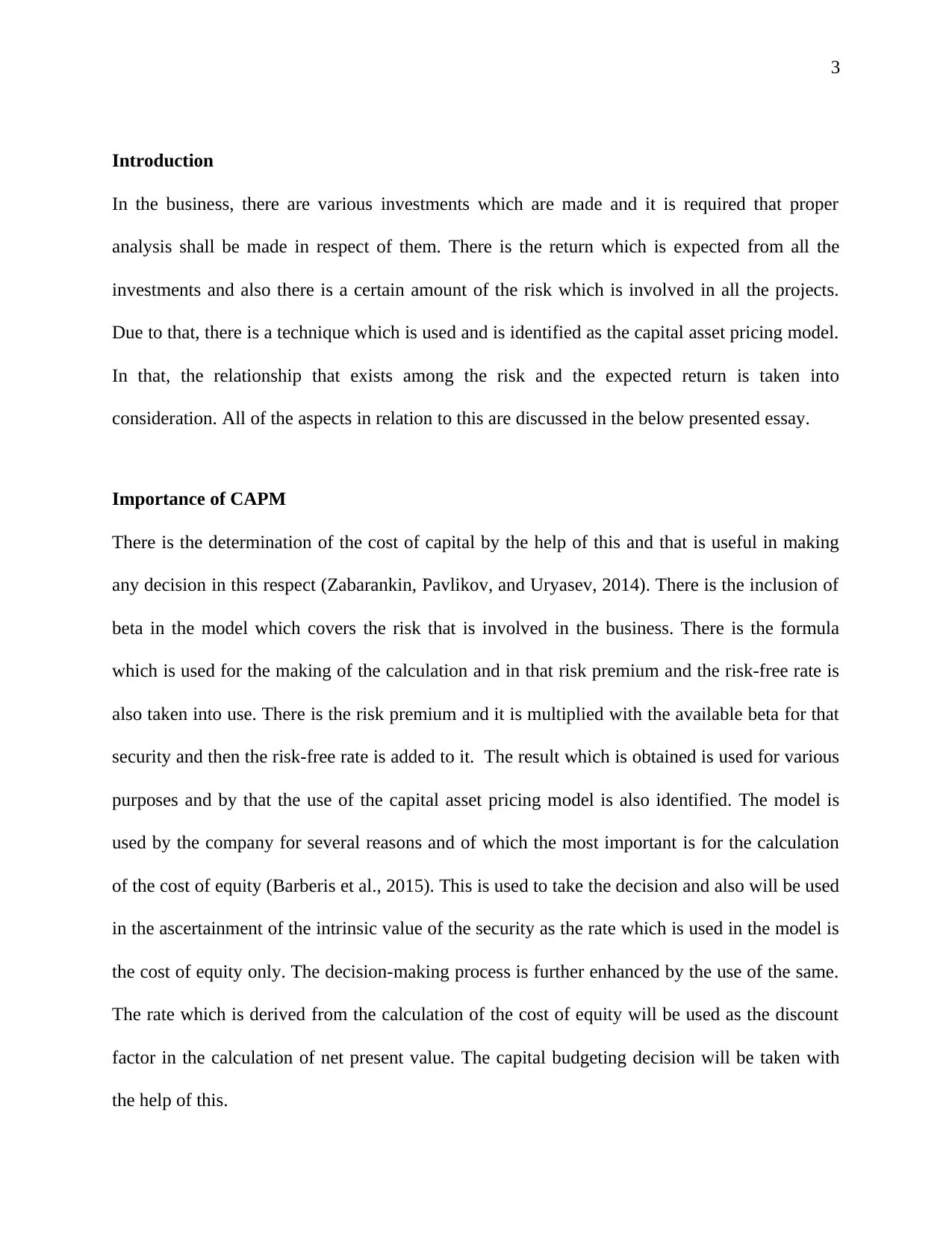
3
Introduction
In the business, there are various investments which are made and it is required that proper
analysis shall be made in respect of them. There is the return which is expected from all the
investments and also there is a certain amount of the risk which is involved in all the projects.
Due to that, there is a technique which is used and is identified as the capital asset pricing model.
In that, the relationship that exists among the risk and the expected return is taken into
consideration. All of the aspects in relation to this are discussed in the below presented essay.
Importance of CAPM
There is the determination of the cost of capital by the help of this and that is useful in making
any decision in this respect (Zabarankin, Pavlikov, and Uryasev, 2014). There is the inclusion of
beta in the model which covers the risk that is involved in the business. There is the formula
which is used for the making of the calculation and in that risk premium and the risk-free rate is
also taken into use. There is the risk premium and it is multiplied with the available beta for that
security and then the risk-free rate is added to it. The result which is obtained is used for various
purposes and by that the use of the capital asset pricing model is also identified. The model is
used by the company for several reasons and of which the most important is for the calculation
of the cost of equity (Barberis et al., 2015). This is used to take the decision and also will be used
in the ascertainment of the intrinsic value of the security as the rate which is used in the model is
the cost of equity only. The decision-making process is further enhanced by the use of the same.
The rate which is derived from the calculation of the cost of equity will be used as the discount
factor in the calculation of net present value. The capital budgeting decision will be taken with
the help of this.
Introduction
In the business, there are various investments which are made and it is required that proper
analysis shall be made in respect of them. There is the return which is expected from all the
investments and also there is a certain amount of the risk which is involved in all the projects.
Due to that, there is a technique which is used and is identified as the capital asset pricing model.
In that, the relationship that exists among the risk and the expected return is taken into
consideration. All of the aspects in relation to this are discussed in the below presented essay.
Importance of CAPM
There is the determination of the cost of capital by the help of this and that is useful in making
any decision in this respect (Zabarankin, Pavlikov, and Uryasev, 2014). There is the inclusion of
beta in the model which covers the risk that is involved in the business. There is the formula
which is used for the making of the calculation and in that risk premium and the risk-free rate is
also taken into use. There is the risk premium and it is multiplied with the available beta for that
security and then the risk-free rate is added to it. The result which is obtained is used for various
purposes and by that the use of the capital asset pricing model is also identified. The model is
used by the company for several reasons and of which the most important is for the calculation
of the cost of equity (Barberis et al., 2015). This is used to take the decision and also will be used
in the ascertainment of the intrinsic value of the security as the rate which is used in the model is
the cost of equity only. The decision-making process is further enhanced by the use of the same.
The rate which is derived from the calculation of the cost of equity will be used as the discount
factor in the calculation of net present value. The capital budgeting decision will be taken with
the help of this.
⊘ This is a preview!⊘
Do you want full access?
Subscribe today to unlock all pages.

Trusted by 1+ million students worldwide
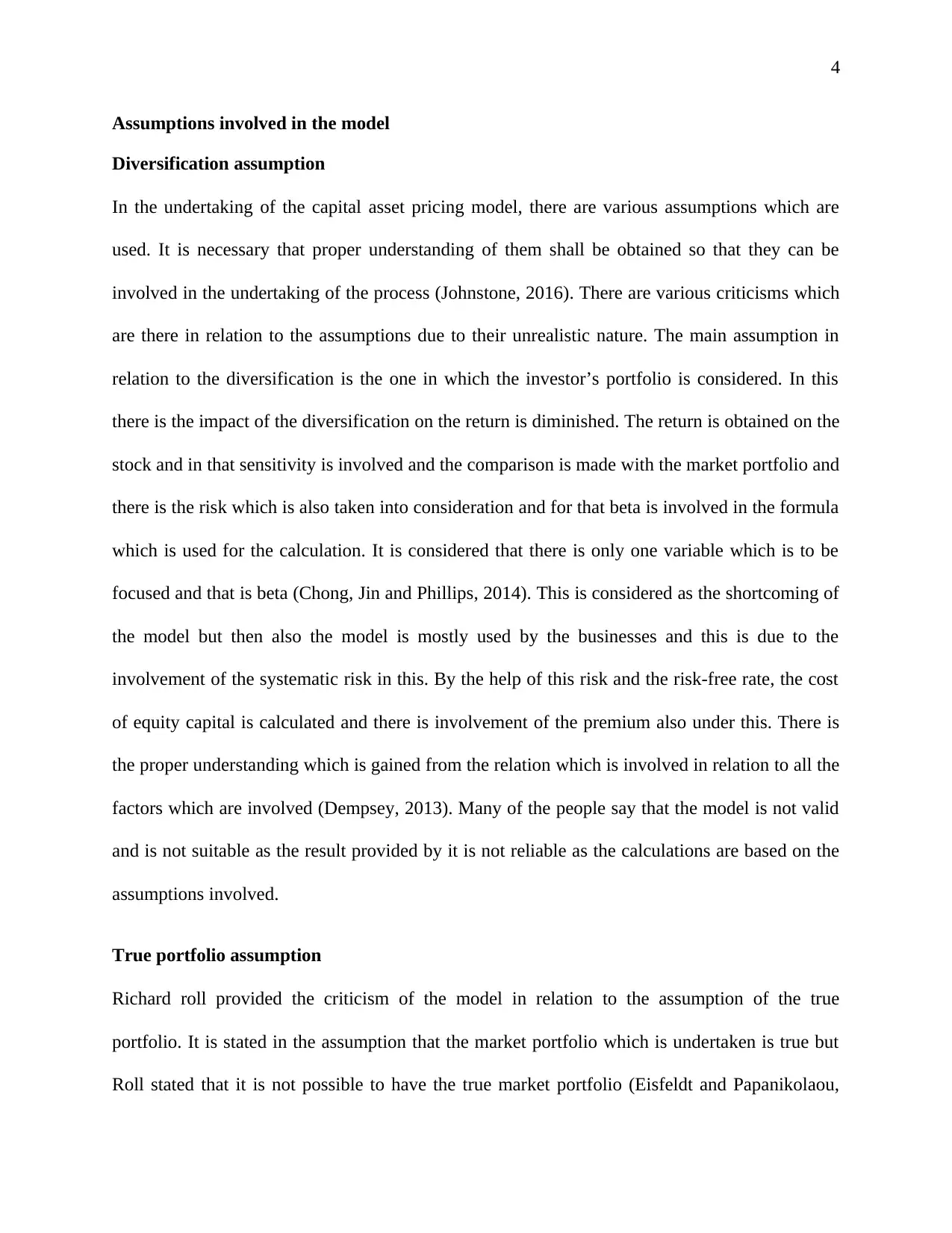
4
Assumptions involved in the model
Diversification assumption
In the undertaking of the capital asset pricing model, there are various assumptions which are
used. It is necessary that proper understanding of them shall be obtained so that they can be
involved in the undertaking of the process (Johnstone, 2016). There are various criticisms which
are there in relation to the assumptions due to their unrealistic nature. The main assumption in
relation to the diversification is the one in which the investor’s portfolio is considered. In this
there is the impact of the diversification on the return is diminished. The return is obtained on the
stock and in that sensitivity is involved and the comparison is made with the market portfolio and
there is the risk which is also taken into consideration and for that beta is involved in the formula
which is used for the calculation. It is considered that there is only one variable which is to be
focused and that is beta (Chong, Jin and Phillips, 2014). This is considered as the shortcoming of
the model but then also the model is mostly used by the businesses and this is due to the
involvement of the systematic risk in this. By the help of this risk and the risk-free rate, the cost
of equity capital is calculated and there is involvement of the premium also under this. There is
the proper understanding which is gained from the relation which is involved in relation to all the
factors which are involved (Dempsey, 2013). Many of the people say that the model is not valid
and is not suitable as the result provided by it is not reliable as the calculations are based on the
assumptions involved.
True portfolio assumption
Richard roll provided the criticism of the model in relation to the assumption of the true
portfolio. It is stated in the assumption that the market portfolio which is undertaken is true but
Roll stated that it is not possible to have the true market portfolio (Eisfeldt and Papanikolaou,
Assumptions involved in the model
Diversification assumption
In the undertaking of the capital asset pricing model, there are various assumptions which are
used. It is necessary that proper understanding of them shall be obtained so that they can be
involved in the undertaking of the process (Johnstone, 2016). There are various criticisms which
are there in relation to the assumptions due to their unrealistic nature. The main assumption in
relation to the diversification is the one in which the investor’s portfolio is considered. In this
there is the impact of the diversification on the return is diminished. The return is obtained on the
stock and in that sensitivity is involved and the comparison is made with the market portfolio and
there is the risk which is also taken into consideration and for that beta is involved in the formula
which is used for the calculation. It is considered that there is only one variable which is to be
focused and that is beta (Chong, Jin and Phillips, 2014). This is considered as the shortcoming of
the model but then also the model is mostly used by the businesses and this is due to the
involvement of the systematic risk in this. By the help of this risk and the risk-free rate, the cost
of equity capital is calculated and there is involvement of the premium also under this. There is
the proper understanding which is gained from the relation which is involved in relation to all the
factors which are involved (Dempsey, 2013). Many of the people say that the model is not valid
and is not suitable as the result provided by it is not reliable as the calculations are based on the
assumptions involved.
True portfolio assumption
Richard roll provided the criticism of the model in relation to the assumption of the true
portfolio. It is stated in the assumption that the market portfolio which is undertaken is true but
Roll stated that it is not possible to have the true market portfolio (Eisfeldt and Papanikolaou,
Paraphrase This Document
Need a fresh take? Get an instant paraphrase of this document with our AI Paraphraser
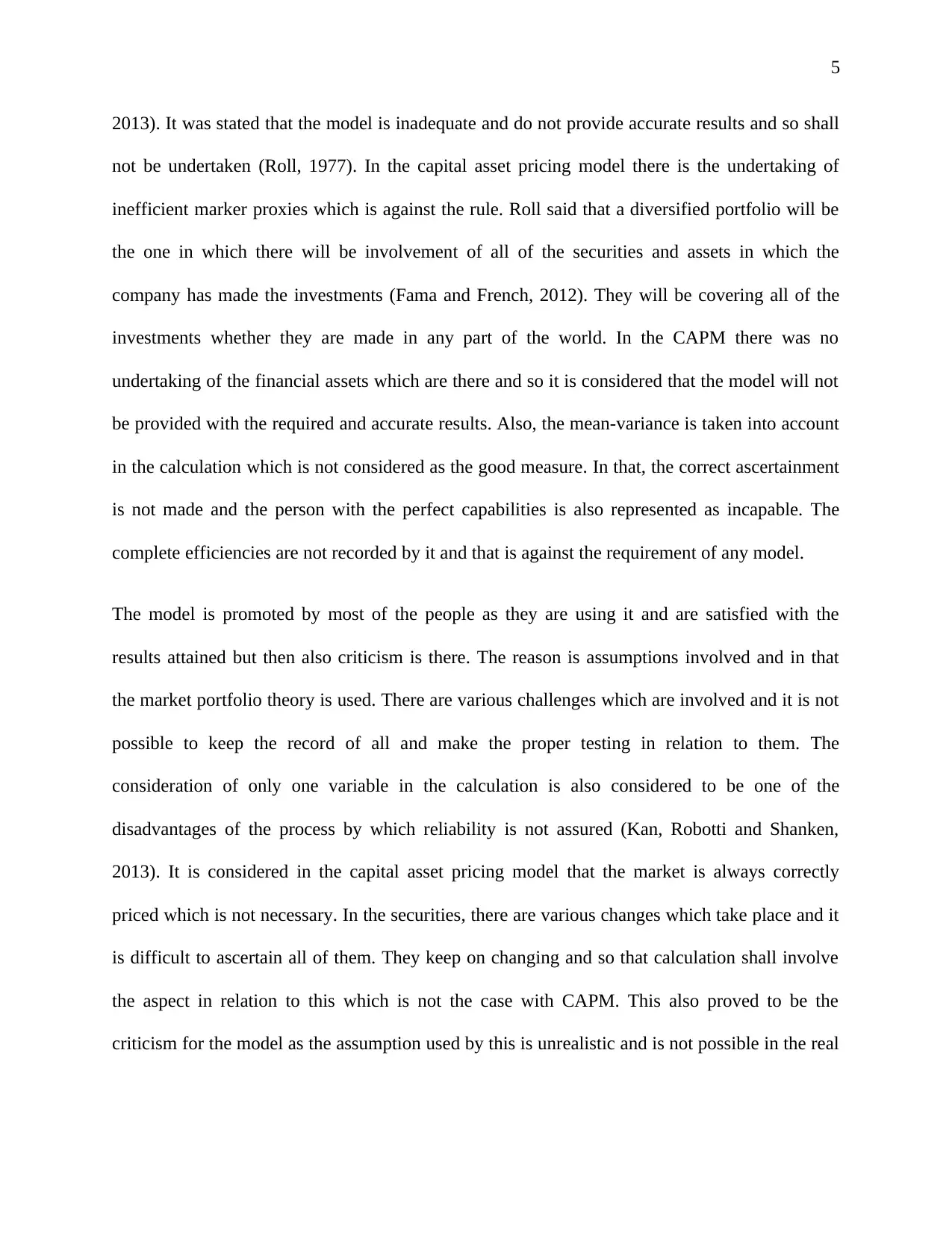
5
2013). It was stated that the model is inadequate and do not provide accurate results and so shall
not be undertaken (Roll, 1977). In the capital asset pricing model there is the undertaking of
inefficient marker proxies which is against the rule. Roll said that a diversified portfolio will be
the one in which there will be involvement of all of the securities and assets in which the
company has made the investments (Fama and French, 2012). They will be covering all of the
investments whether they are made in any part of the world. In the CAPM there was no
undertaking of the financial assets which are there and so it is considered that the model will not
be provided with the required and accurate results. Also, the mean-variance is taken into account
in the calculation which is not considered as the good measure. In that, the correct ascertainment
is not made and the person with the perfect capabilities is also represented as incapable. The
complete efficiencies are not recorded by it and that is against the requirement of any model.
The model is promoted by most of the people as they are using it and are satisfied with the
results attained but then also criticism is there. The reason is assumptions involved and in that
the market portfolio theory is used. There are various challenges which are involved and it is not
possible to keep the record of all and make the proper testing in relation to them. The
consideration of only one variable in the calculation is also considered to be one of the
disadvantages of the process by which reliability is not assured (Kan, Robotti and Shanken,
2013). It is considered in the capital asset pricing model that the market is always correctly
priced which is not necessary. In the securities, there are various changes which take place and it
is difficult to ascertain all of them. They keep on changing and so that calculation shall involve
the aspect in relation to this which is not the case with CAPM. This also proved to be the
criticism for the model as the assumption used by this is unrealistic and is not possible in the real
2013). It was stated that the model is inadequate and do not provide accurate results and so shall
not be undertaken (Roll, 1977). In the capital asset pricing model there is the undertaking of
inefficient marker proxies which is against the rule. Roll said that a diversified portfolio will be
the one in which there will be involvement of all of the securities and assets in which the
company has made the investments (Fama and French, 2012). They will be covering all of the
investments whether they are made in any part of the world. In the CAPM there was no
undertaking of the financial assets which are there and so it is considered that the model will not
be provided with the required and accurate results. Also, the mean-variance is taken into account
in the calculation which is not considered as the good measure. In that, the correct ascertainment
is not made and the person with the perfect capabilities is also represented as incapable. The
complete efficiencies are not recorded by it and that is against the requirement of any model.
The model is promoted by most of the people as they are using it and are satisfied with the
results attained but then also criticism is there. The reason is assumptions involved and in that
the market portfolio theory is used. There are various challenges which are involved and it is not
possible to keep the record of all and make the proper testing in relation to them. The
consideration of only one variable in the calculation is also considered to be one of the
disadvantages of the process by which reliability is not assured (Kan, Robotti and Shanken,
2013). It is considered in the capital asset pricing model that the market is always correctly
priced which is not necessary. In the securities, there are various changes which take place and it
is difficult to ascertain all of them. They keep on changing and so that calculation shall involve
the aspect in relation to this which is not the case with CAPM. This also proved to be the
criticism for the model as the assumption used by this is unrealistic and is not possible in the real
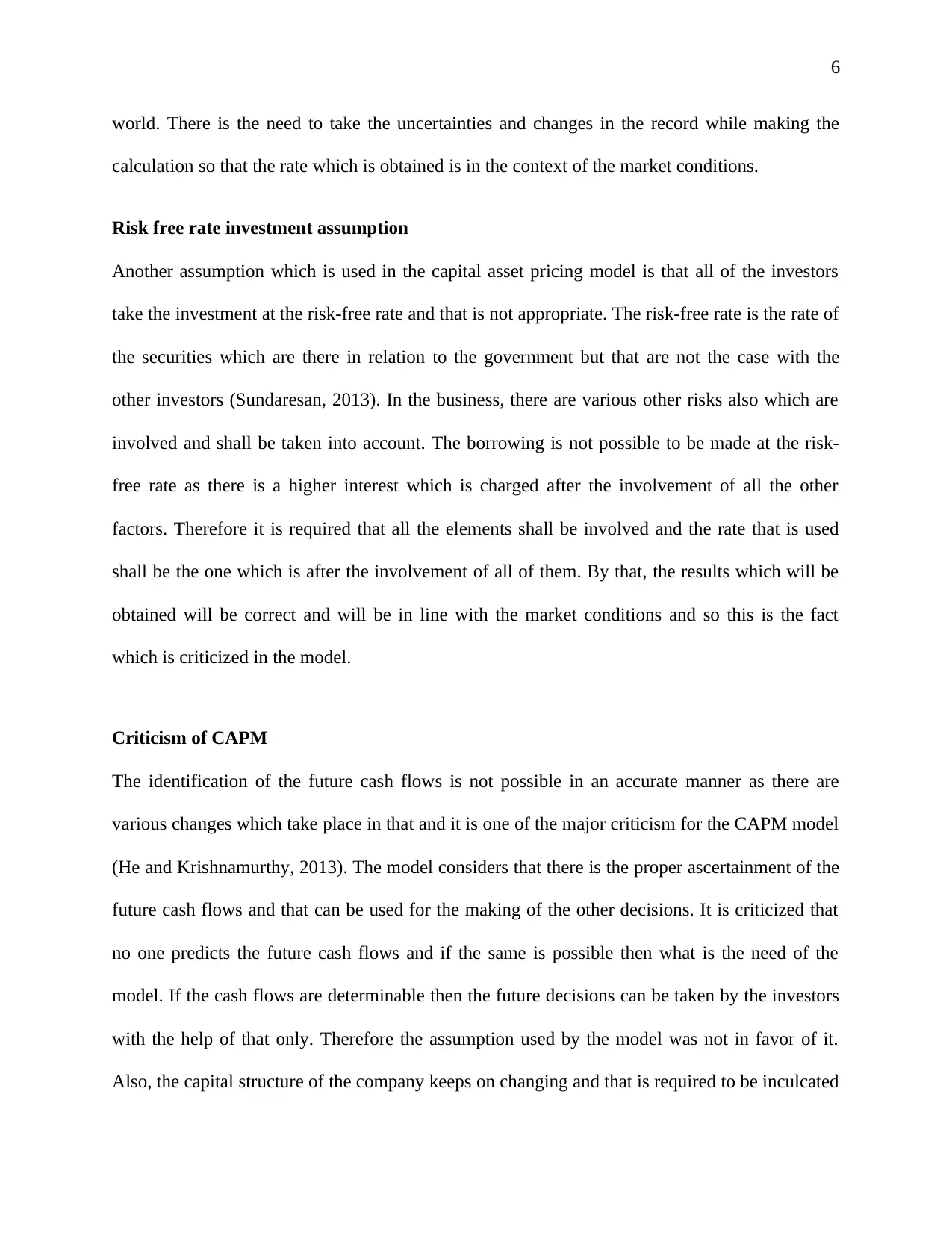
6
world. There is the need to take the uncertainties and changes in the record while making the
calculation so that the rate which is obtained is in the context of the market conditions.
Risk free rate investment assumption
Another assumption which is used in the capital asset pricing model is that all of the investors
take the investment at the risk-free rate and that is not appropriate. The risk-free rate is the rate of
the securities which are there in relation to the government but that are not the case with the
other investors (Sundaresan, 2013). In the business, there are various other risks also which are
involved and shall be taken into account. The borrowing is not possible to be made at the risk-
free rate as there is a higher interest which is charged after the involvement of all the other
factors. Therefore it is required that all the elements shall be involved and the rate that is used
shall be the one which is after the involvement of all of them. By that, the results which will be
obtained will be correct and will be in line with the market conditions and so this is the fact
which is criticized in the model.
Criticism of CAPM
The identification of the future cash flows is not possible in an accurate manner as there are
various changes which take place in that and it is one of the major criticism for the CAPM model
(He and Krishnamurthy, 2013). The model considers that there is the proper ascertainment of the
future cash flows and that can be used for the making of the other decisions. It is criticized that
no one predicts the future cash flows and if the same is possible then what is the need of the
model. If the cash flows are determinable then the future decisions can be taken by the investors
with the help of that only. Therefore the assumption used by the model was not in favor of it.
Also, the capital structure of the company keeps on changing and that is required to be inculcated
world. There is the need to take the uncertainties and changes in the record while making the
calculation so that the rate which is obtained is in the context of the market conditions.
Risk free rate investment assumption
Another assumption which is used in the capital asset pricing model is that all of the investors
take the investment at the risk-free rate and that is not appropriate. The risk-free rate is the rate of
the securities which are there in relation to the government but that are not the case with the
other investors (Sundaresan, 2013). In the business, there are various other risks also which are
involved and shall be taken into account. The borrowing is not possible to be made at the risk-
free rate as there is a higher interest which is charged after the involvement of all the other
factors. Therefore it is required that all the elements shall be involved and the rate that is used
shall be the one which is after the involvement of all of them. By that, the results which will be
obtained will be correct and will be in line with the market conditions and so this is the fact
which is criticized in the model.
Criticism of CAPM
The identification of the future cash flows is not possible in an accurate manner as there are
various changes which take place in that and it is one of the major criticism for the CAPM model
(He and Krishnamurthy, 2013). The model considers that there is the proper ascertainment of the
future cash flows and that can be used for the making of the other decisions. It is criticized that
no one predicts the future cash flows and if the same is possible then what is the need of the
model. If the cash flows are determinable then the future decisions can be taken by the investors
with the help of that only. Therefore the assumption used by the model was not in favor of it.
Also, the capital structure of the company keeps on changing and that is required to be inculcated
⊘ This is a preview!⊘
Do you want full access?
Subscribe today to unlock all pages.

Trusted by 1+ million students worldwide
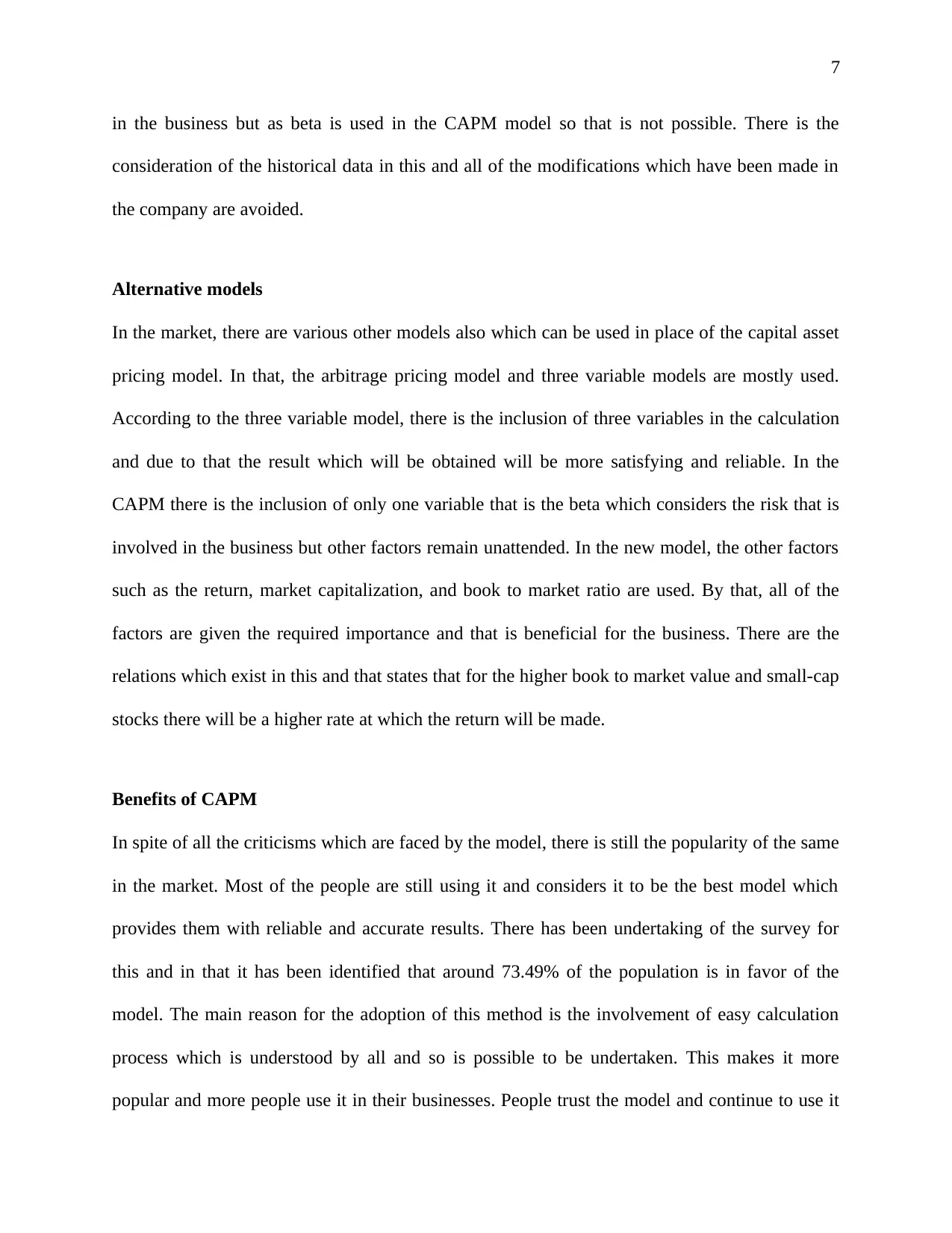
7
in the business but as beta is used in the CAPM model so that is not possible. There is the
consideration of the historical data in this and all of the modifications which have been made in
the company are avoided.
Alternative models
In the market, there are various other models also which can be used in place of the capital asset
pricing model. In that, the arbitrage pricing model and three variable models are mostly used.
According to the three variable model, there is the inclusion of three variables in the calculation
and due to that the result which will be obtained will be more satisfying and reliable. In the
CAPM there is the inclusion of only one variable that is the beta which considers the risk that is
involved in the business but other factors remain unattended. In the new model, the other factors
such as the return, market capitalization, and book to market ratio are used. By that, all of the
factors are given the required importance and that is beneficial for the business. There are the
relations which exist in this and that states that for the higher book to market value and small-cap
stocks there will be a higher rate at which the return will be made.
Benefits of CAPM
In spite of all the criticisms which are faced by the model, there is still the popularity of the same
in the market. Most of the people are still using it and considers it to be the best model which
provides them with reliable and accurate results. There has been undertaking of the survey for
this and in that it has been identified that around 73.49% of the population is in favor of the
model. The main reason for the adoption of this method is the involvement of easy calculation
process which is understood by all and so is possible to be undertaken. This makes it more
popular and more people use it in their businesses. People trust the model and continue to use it
in the business but as beta is used in the CAPM model so that is not possible. There is the
consideration of the historical data in this and all of the modifications which have been made in
the company are avoided.
Alternative models
In the market, there are various other models also which can be used in place of the capital asset
pricing model. In that, the arbitrage pricing model and three variable models are mostly used.
According to the three variable model, there is the inclusion of three variables in the calculation
and due to that the result which will be obtained will be more satisfying and reliable. In the
CAPM there is the inclusion of only one variable that is the beta which considers the risk that is
involved in the business but other factors remain unattended. In the new model, the other factors
such as the return, market capitalization, and book to market ratio are used. By that, all of the
factors are given the required importance and that is beneficial for the business. There are the
relations which exist in this and that states that for the higher book to market value and small-cap
stocks there will be a higher rate at which the return will be made.
Benefits of CAPM
In spite of all the criticisms which are faced by the model, there is still the popularity of the same
in the market. Most of the people are still using it and considers it to be the best model which
provides them with reliable and accurate results. There has been undertaking of the survey for
this and in that it has been identified that around 73.49% of the population is in favor of the
model. The main reason for the adoption of this method is the involvement of easy calculation
process which is understood by all and so is possible to be undertaken. This makes it more
popular and more people use it in their businesses. People trust the model and continue to use it
Paraphrase This Document
Need a fresh take? Get an instant paraphrase of this document with our AI Paraphraser
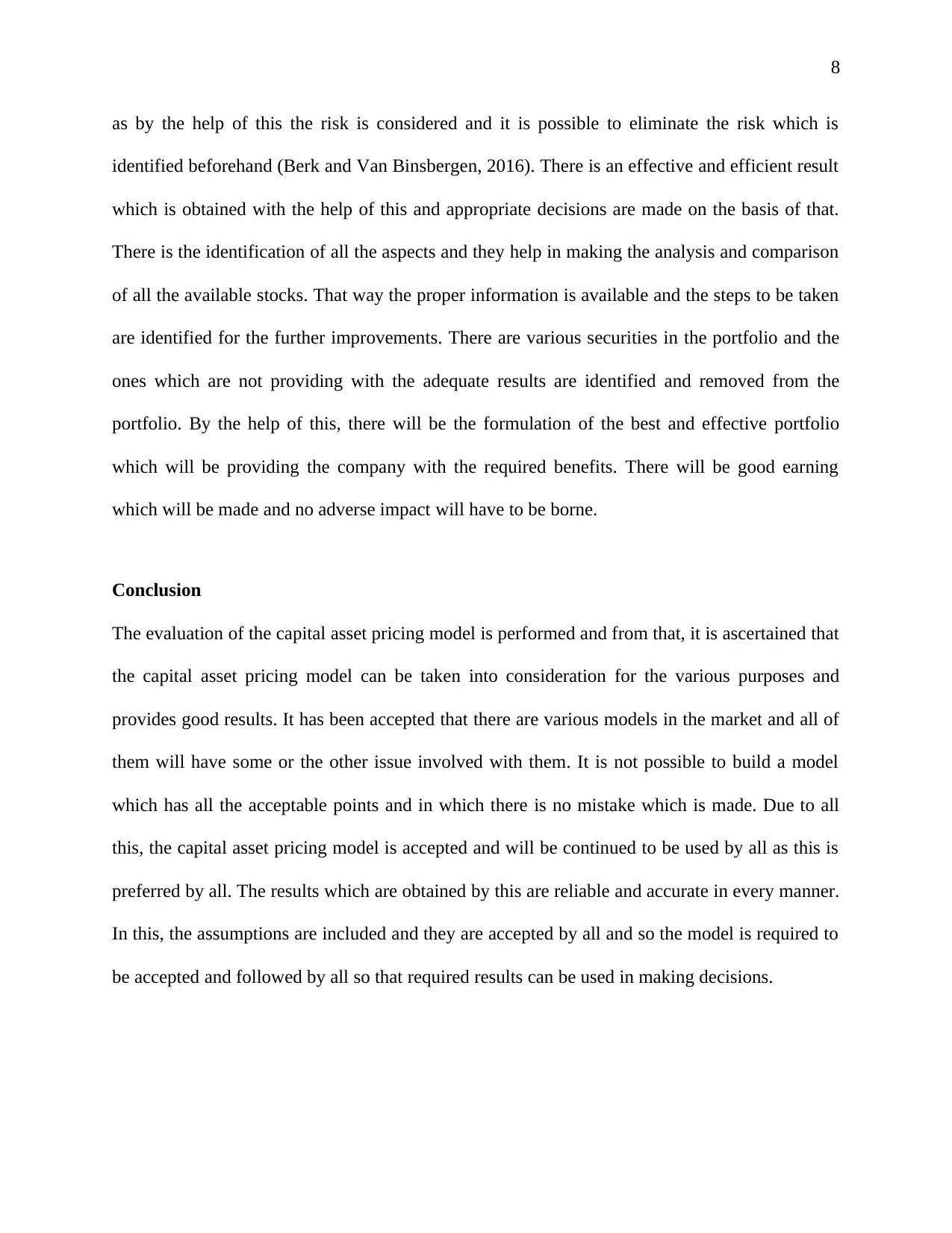
8
as by the help of this the risk is considered and it is possible to eliminate the risk which is
identified beforehand (Berk and Van Binsbergen, 2016). There is an effective and efficient result
which is obtained with the help of this and appropriate decisions are made on the basis of that.
There is the identification of all the aspects and they help in making the analysis and comparison
of all the available stocks. That way the proper information is available and the steps to be taken
are identified for the further improvements. There are various securities in the portfolio and the
ones which are not providing with the adequate results are identified and removed from the
portfolio. By the help of this, there will be the formulation of the best and effective portfolio
which will be providing the company with the required benefits. There will be good earning
which will be made and no adverse impact will have to be borne.
Conclusion
The evaluation of the capital asset pricing model is performed and from that, it is ascertained that
the capital asset pricing model can be taken into consideration for the various purposes and
provides good results. It has been accepted that there are various models in the market and all of
them will have some or the other issue involved with them. It is not possible to build a model
which has all the acceptable points and in which there is no mistake which is made. Due to all
this, the capital asset pricing model is accepted and will be continued to be used by all as this is
preferred by all. The results which are obtained by this are reliable and accurate in every manner.
In this, the assumptions are included and they are accepted by all and so the model is required to
be accepted and followed by all so that required results can be used in making decisions.
as by the help of this the risk is considered and it is possible to eliminate the risk which is
identified beforehand (Berk and Van Binsbergen, 2016). There is an effective and efficient result
which is obtained with the help of this and appropriate decisions are made on the basis of that.
There is the identification of all the aspects and they help in making the analysis and comparison
of all the available stocks. That way the proper information is available and the steps to be taken
are identified for the further improvements. There are various securities in the portfolio and the
ones which are not providing with the adequate results are identified and removed from the
portfolio. By the help of this, there will be the formulation of the best and effective portfolio
which will be providing the company with the required benefits. There will be good earning
which will be made and no adverse impact will have to be borne.
Conclusion
The evaluation of the capital asset pricing model is performed and from that, it is ascertained that
the capital asset pricing model can be taken into consideration for the various purposes and
provides good results. It has been accepted that there are various models in the market and all of
them will have some or the other issue involved with them. It is not possible to build a model
which has all the acceptable points and in which there is no mistake which is made. Due to all
this, the capital asset pricing model is accepted and will be continued to be used by all as this is
preferred by all. The results which are obtained by this are reliable and accurate in every manner.
In this, the assumptions are included and they are accepted by all and so the model is required to
be accepted and followed by all so that required results can be used in making decisions.
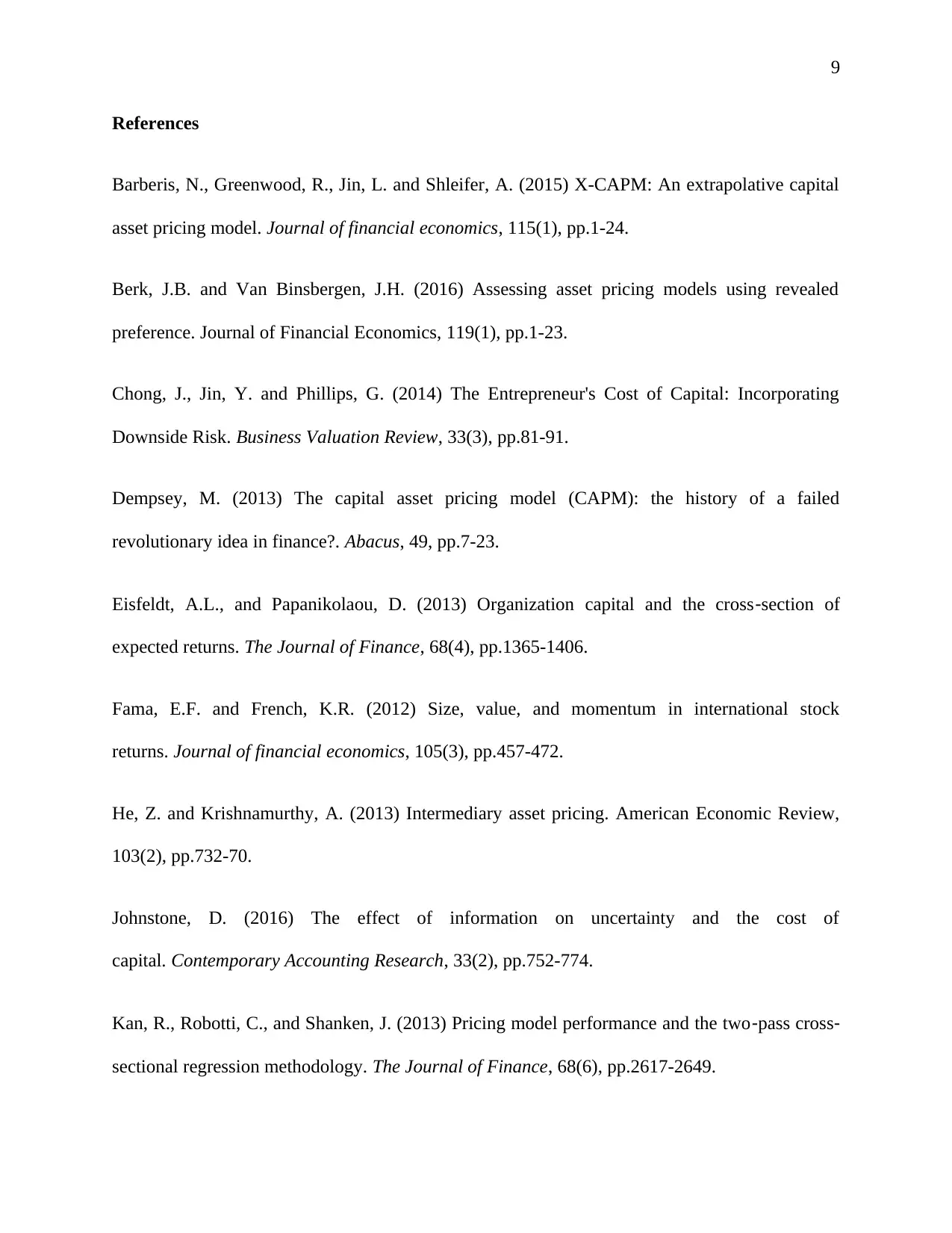
9
References
Barberis, N., Greenwood, R., Jin, L. and Shleifer, A. (2015) X-CAPM: An extrapolative capital
asset pricing model. Journal of financial economics, 115(1), pp.1-24.
Berk, J.B. and Van Binsbergen, J.H. (2016) Assessing asset pricing models using revealed
preference. Journal of Financial Economics, 119(1), pp.1-23.
Chong, J., Jin, Y. and Phillips, G. (2014) The Entrepreneur's Cost of Capital: Incorporating
Downside Risk. Business Valuation Review, 33(3), pp.81-91.
Dempsey, M. (2013) The capital asset pricing model (CAPM): the history of a failed
revolutionary idea in finance?. Abacus, 49, pp.7-23.
Eisfeldt, A.L., and Papanikolaou, D. (2013) Organization capital and the cross‐section of
expected returns. The Journal of Finance, 68(4), pp.1365-1406.
Fama, E.F. and French, K.R. (2012) Size, value, and momentum in international stock
returns. Journal of financial economics, 105(3), pp.457-472.
He, Z. and Krishnamurthy, A. (2013) Intermediary asset pricing. American Economic Review,
103(2), pp.732-70.
Johnstone, D. (2016) The effect of information on uncertainty and the cost of
capital. Contemporary Accounting Research, 33(2), pp.752-774.
Kan, R., Robotti, C., and Shanken, J. (2013) Pricing model performance and the two‐pass cross‐
sectional regression methodology. The Journal of Finance, 68(6), pp.2617-2649.
References
Barberis, N., Greenwood, R., Jin, L. and Shleifer, A. (2015) X-CAPM: An extrapolative capital
asset pricing model. Journal of financial economics, 115(1), pp.1-24.
Berk, J.B. and Van Binsbergen, J.H. (2016) Assessing asset pricing models using revealed
preference. Journal of Financial Economics, 119(1), pp.1-23.
Chong, J., Jin, Y. and Phillips, G. (2014) The Entrepreneur's Cost of Capital: Incorporating
Downside Risk. Business Valuation Review, 33(3), pp.81-91.
Dempsey, M. (2013) The capital asset pricing model (CAPM): the history of a failed
revolutionary idea in finance?. Abacus, 49, pp.7-23.
Eisfeldt, A.L., and Papanikolaou, D. (2013) Organization capital and the cross‐section of
expected returns. The Journal of Finance, 68(4), pp.1365-1406.
Fama, E.F. and French, K.R. (2012) Size, value, and momentum in international stock
returns. Journal of financial economics, 105(3), pp.457-472.
He, Z. and Krishnamurthy, A. (2013) Intermediary asset pricing. American Economic Review,
103(2), pp.732-70.
Johnstone, D. (2016) The effect of information on uncertainty and the cost of
capital. Contemporary Accounting Research, 33(2), pp.752-774.
Kan, R., Robotti, C., and Shanken, J. (2013) Pricing model performance and the two‐pass cross‐
sectional regression methodology. The Journal of Finance, 68(6), pp.2617-2649.
⊘ This is a preview!⊘
Do you want full access?
Subscribe today to unlock all pages.

Trusted by 1+ million students worldwide
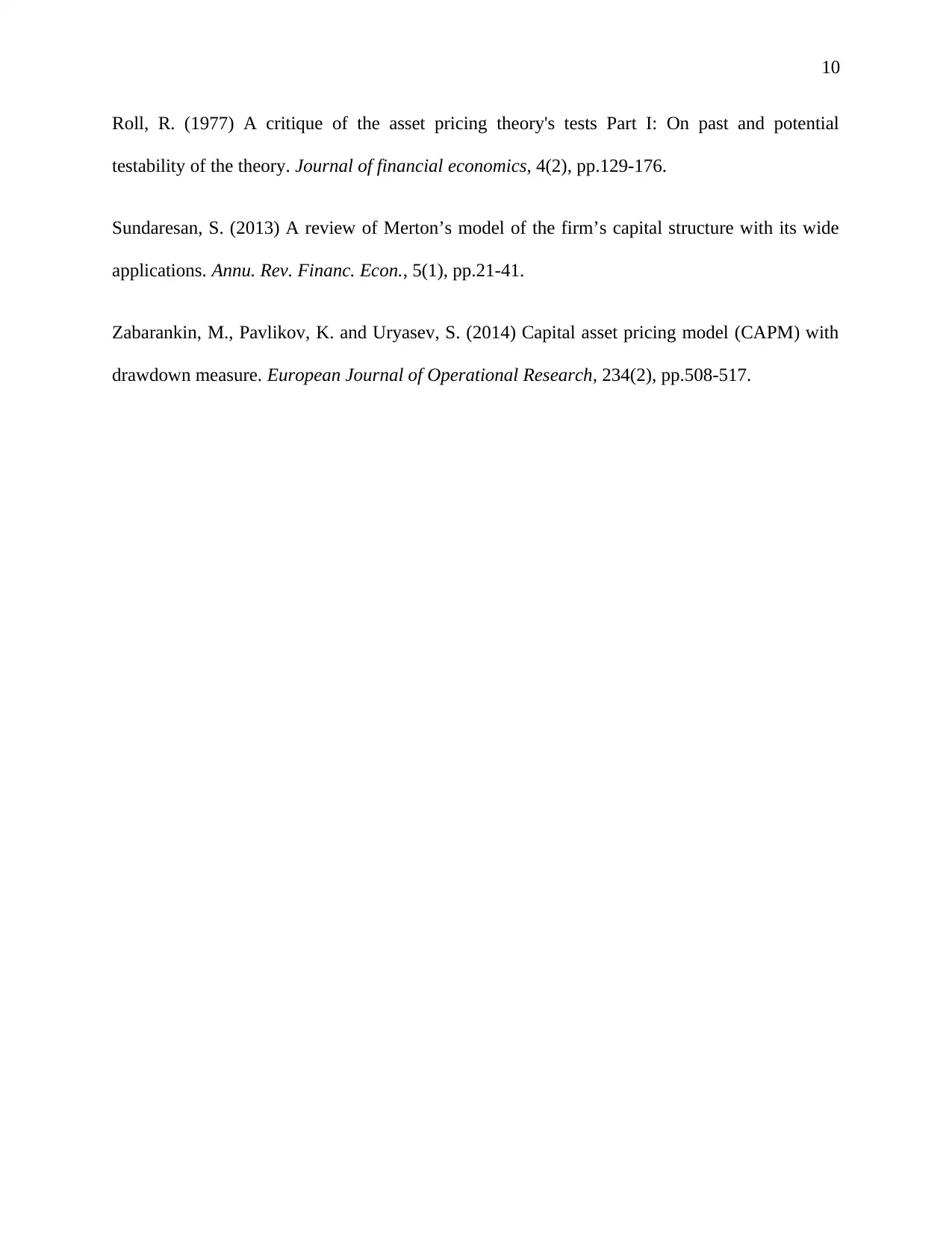
10
Roll, R. (1977) A critique of the asset pricing theory's tests Part I: On past and potential
testability of the theory. Journal of financial economics, 4(2), pp.129-176.
Sundaresan, S. (2013) A review of Merton’s model of the firm’s capital structure with its wide
applications. Annu. Rev. Financ. Econ., 5(1), pp.21-41.
Zabarankin, M., Pavlikov, K. and Uryasev, S. (2014) Capital asset pricing model (CAPM) with
drawdown measure. European Journal of Operational Research, 234(2), pp.508-517.
Roll, R. (1977) A critique of the asset pricing theory's tests Part I: On past and potential
testability of the theory. Journal of financial economics, 4(2), pp.129-176.
Sundaresan, S. (2013) A review of Merton’s model of the firm’s capital structure with its wide
applications. Annu. Rev. Financ. Econ., 5(1), pp.21-41.
Zabarankin, M., Pavlikov, K. and Uryasev, S. (2014) Capital asset pricing model (CAPM) with
drawdown measure. European Journal of Operational Research, 234(2), pp.508-517.
1 out of 10
Related Documents
Your All-in-One AI-Powered Toolkit for Academic Success.
+13062052269
info@desklib.com
Available 24*7 on WhatsApp / Email
![[object Object]](/_next/static/media/star-bottom.7253800d.svg)
Unlock your academic potential
Copyright © 2020–2025 A2Z Services. All Rights Reserved. Developed and managed by ZUCOL.





